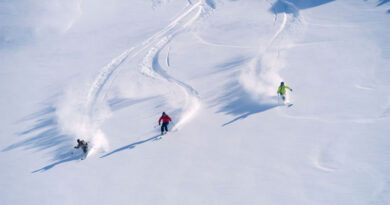Can you use Ski Boots for Walking?
Walking in ski boots depends on what you mean by “walking” in this question. If you mean “walking” as in, can you walk at all, then yes, you can (apologies for stating the obvious). But if you mean going on long strides and walking comfortably as if they were hiking boots, then, no!
Boots are meant for walking. But that is not the primary function of every boot in existence. Specialized boots like ski boots are meant for skiing, primarily (again, apologies for the obvious). But you have to walk even in specialized boots sooner or later like walking from the car parking or hotel room to the ski resort.
Is it Hard to Walk in Ski Boots?
It can be hard for beginners who just put their feet in a pair of ski boots for the first time. These people feel so insecure that they can barely stand without support. To beginners, ski boots feel unnatural, and so, they have problems walking. Others complain of pain in feet and legs from walking in ski boots.
Why…?
Ski boots are heavier than normal boots. The heavy weight affects the dynamics of walking. During normal walking, when you lift one leg, your shoulders and hips work as a counterbalance. With the heavy weight of ski boots, you have to adjust the motion of your shoulders and hips to provide the necessary counterbalance.
Ski boots are also stiff. The stiffness is necessary to provide support during skiing. But these boots provide no flexibility and room to move for your feet. Walking in these stiff boots is painful for your feet and ankles. A natural walking position also puts strain on your back. You should only walk wearing ski boots where it is necessary.
The Walk Mode
Some ski boots have a walk mode to assist in walking. Walk mode has been around for quite some time now. What walk mode does is it releases the upper and lower cuff from one another. The release allows natural movement of the ankles.
How to Put Boots in the Walk Mode?
Ski boots with walk mode have a clasp or a small lever that is used to put the boot in ski or walk mode. Usually, the clasp shows the direction in which pulling would activate ski and walk mode. When the walk mode is activated, you will feel the boot becoming loose and allowing more range of motion.
Disadvantages…?
There is a complete debate about whether ski boots should have walk mode or not. Both sides have convincing arguments. While walk mode is useful, it also has its disadvantages.
- For one, incorporating an additional mechanism makes the boots heavier.
- Mechanisms also tend to fail. If the mechanism fails during skiing and switches to walk mode, it will become less rigid affecting your performance.
- Having walk mode in the boots is another thing to remember. You can easily forget to switch the boots back into ski mode once you put them in walk mode or vice versa.
What if Ski Boots don’t have a Walk Mode?
Not all boots have a walk mode. In that case, you would learn how to walk in ski boots. As mentioned above, as soon as you adjust the motion of your shoulders and hips to effectively counterbalance your boots, you can walk just fine. Going uphill and downhill can be intimidating for a beginner but it’s no big deal. Here are a few tips:
- When walking on a flat surface, it is easier to walk normally with your heel and toe.
- If you are going uphill, walk on the tips of your toes by kicking them in the snow.
- If you are going downhill, walk on your heels by digging them in the snow.
Ski Boot Soles and Walking
Ski boot soles also play an important role in how much you can walk in your boots. Some soles make it easy for you to walk while it is harder in others. Ski boots are available with many types of soles. But there are four common types of boot soles that a normal consumer would come across. They are as follows:
Alpine ISO 5355
Alpine ISO 5355 is the most common type of sole in ski boots. It is often called “DIN” or “Alpine” soles. They have a flat profile with hard plastic for better power transmission. But the same flat profile and hard plastic make the soles very slippery. You should avoid walking in Alpine soles or you will most probably get a leg injury.
Alpine Touring Soles ISO 9523
ISO 9523 is the second established standard for ski boot soles. This standard is developed for touring ski boots. These soles are made of rubber and have a rockered profile. The rubber in the soles provides traction for walking. These soles are better for walking than the ISO 5355 mentioned above.
WTR and GripWalk soles (mentioned below) also meet the ISO 9523 standard. These soles will work in any binding designated for ISO 9523.
GripWalk Soles
GripWalk has been common in ski boots over the past several years. It provides better traction and allows a more natural stride than Alpine soles. GripWalk soles are defined by the standard ISO 23223 and are compatible with bindings that display the GripWalk logo.
Walk to Ride (WTR) Soles
WTR soles were developed to combine the best both, of ISO 5355 and ISO 9523. The idea was the same as that of GripWalk. You get boot soles that let you ride as well as walk. But recently, the industry has adopted GripWalk as the standard for improved walking soles and WTR is being phased out.




